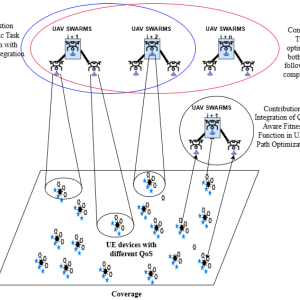Introduction: Transforming Military Operations
In recent years, the US Army has been undergoing a significant transformation in its operational capabilities. With rapid advancements in technology, the US Army shifting towards unmanned systems. This strategic shift is aimed at enhancing efficiency, reducing risks to personnel, and maintaining a technological edge over potential adversaries. Unmanned systems, including drones, autonomous ground vehicles, and robotic systems, are set to play a pivotal role in the future battlefield.

The Evolution of Unmanned Systems in the Military
The concept of unmanned systems is not new. However, recent advancements in artificial intelligence (AI), machine learning (ML), and robotics have brought about a revolution in how these systems are designed, deployed, and utilized. Early iterations of unmanned aerial vehicles (UAVs) were primarily used for reconnaissance and surveillance. Today, their roles have expanded to include offensive operations, logistics, and even casualty evacuation.
1. Unmanned Aerial Vehicles (UAVs): Expanding Roles and Capabilities
UAVs, commonly known as drones, have seen exponential growth in their capabilities. Modern UAVs are equipped with advanced sensors, high-resolution cameras, and sophisticated communication systems that allow for real-time data transmission and analysis. The MQ-9 Reaper is a prime example of a UAV that has evolved from a surveillance platform to a versatile asset capable of carrying out precision strikes.
2. Autonomous Ground Vehicles (AGVs): Redefining Ground Warfare
Autonomous ground vehicles are set to revolutionize land warfare. These vehicles, ranging from small reconnaissance robots to fully armored tanks, can operate independently or in coordination with manned units. The Robotic Combat Vehicle (RCV) program aims to develop a family of unmanned ground vehicles that can perform a variety of missions, including reconnaissance, logistics support, and direct combat.
3. Unmanned Maritime Systems: Enhancing Naval Operations
The integration of unmanned systems into naval operations is another area of significant development. Unmanned Underwater Vehicles (UUVs) and Unmanned Surface Vehicles (USVs) are being developed to perform tasks such as mine detection, anti-submarine warfare, and intelligence gathering. These systems enhance the Navy’s operational capabilities while reducing risks to personnel.
Key Technologies Driving Unmanned Systems
The advancements in unmanned systems are largely driven by several key technologies. These include AI and ML, advanced sensors, communication networks, and energy storage solutions.
1. Artificial Intelligence and Machine Learning
AI and ML are at the heart of modern unmanned systems. These technologies enable machines to learn from data, adapt to changing environments, and make decisions autonomously. In military applications, AI is used for tasks such as target recognition, route planning, and predictive maintenance.
2. Advanced Sensors and Data Analytics
The effectiveness of unmanned systems depends heavily on their ability to perceive and understand their environment. Advanced sensors, including lidar, radar, and infrared cameras, provide critical data that is processed using sophisticated algorithms to generate actionable insights.
3. Robust Communication Networks
Unmanned systems require reliable and secure communication networks to operate effectively. Advances in satellite communications (SATCOM), 5G networks, and secure radio systems ensure that these systems can transmit and receive data in real-time, even in contested environments.
4. Energy Storage and Power Management
The endurance of unmanned systems is often limited by their energy storage capabilities. Innovations in battery technology, fuel cells, and solar power are extending the operational range and duration of these systems, making them more versatile and reliable.
Strategic Advantages of Unmanned Systems
The integration of unmanned systems into military operations offers several strategic advantages. These include enhanced situational awareness, reduced risk to personnel, and increased operational efficiency.
1. Enhanced Situational Awareness
Unmanned systems provide unparalleled situational awareness. Equipped with advanced sensors and real-time data transmission capabilities, they offer commanders a comprehensive view of the battlefield. This allows for more informed decision-making and quicker response times.
2. Reduced Risk to Personnel
One of the primary motivations behind the development of unmanned systems is to reduce the risk to human soldiers. By taking on dangerous tasks such as reconnaissance in hostile territory or bomb disposal, these systems protect lives and allow human soldiers to focus on more complex missions.
3. Increased Operational Efficiency
Unmanned systems can operate continuously without the need for rest, making them highly efficient. They can perform repetitive tasks with precision and can be deployed in environments that are too dangerous or inaccessible for human soldiers.
Challenges and Considerations in Deploying Unmanned Systems
While the benefits of unmanned systems are clear, their deployment also presents several challenges. These include technological limitations, ethical considerations, and logistical challenges.
1. Technological Limitations
Despite significant advancements, there are still technological challenges that need to be addressed. These include improving AI algorithms to handle complex decision-making, enhancing sensor accuracy, and developing more efficient energy storage solutions.
2. Ethical and Legal Considerations
The use of unmanned systems, especially those capable of lethal force, raises important ethical and legal questions. Issues such as the rules of engagement, accountability, and the potential for unintended civilian casualties must be carefully considered.
3. Logistical Challenges
Integrating unmanned systems into existing military infrastructure requires significant logistical planning. This includes training personnel, establishing maintenance and repair facilities, and ensuring interoperability with manned systems.
Future Trends in Unmanned Military Systems
The future of unmanned systems in the military looks promising, with several emerging trends that are set to shape the battlefield of tomorrow.
1. Swarm Technology
Swarm technology involves the use of multiple unmanned systems that operate in a coordinated manner. These swarms can overwhelm defenses, conduct complex reconnaissance missions, and provide a level of redundancy that increases mission success rates.
2. Human-Machine Teaming
Human-machine teaming focuses on the seamless integration of human soldiers and unmanned systems. By leveraging the strengths of both, this approach aims to enhance operational effectiveness. Soldiers can focus on strategic decision-making while unmanned systems handle tasks that require precision and endurance.
3. Cybersecurity Enhancements
As unmanned systems become more prevalent, the importance of cybersecurity cannot be overstated. Ensuring that these systems are protected from cyberattacks is crucial to maintaining their effectiveness and preventing adversaries from exploiting vulnerabilities.
4. Modular and Adaptable Designs
Future unmanned systems are likely to feature modular and adaptable designs. This allows for quick upgrades and modifications to address evolving threats and incorporate new technologies. Such flexibility is essential in a rapidly changing technological landscape.
Conclusion: Embracing the Unmanned Future
The integration of unmanned systems into the US Army’s capabilities marks a significant shift in military strategy. These systems offer numerous advantages, from enhanced situational awareness and reduced risk to personnel to increased operational efficiency. However, their deployment also comes with challenges that must be addressed through continued innovation and careful planning.
As we move forward, the focus will be on developing more advanced and capable unmanned systems, exploring new concepts such as swarm technology and human-machine teaming, and ensuring robust cybersecurity measures. By embracing these advancements, the US Army can maintain its technological edge and ensure its readiness for the future battlefield.
The journey towards a largely unmanned military capability is both exciting and challenging. It requires a commitment to technological innovation, ethical considerations, and strategic planning. As we navigate this path, the goal remains clear: to enhance the effectiveness and safety of military operations, securing a better and safer future for all.











